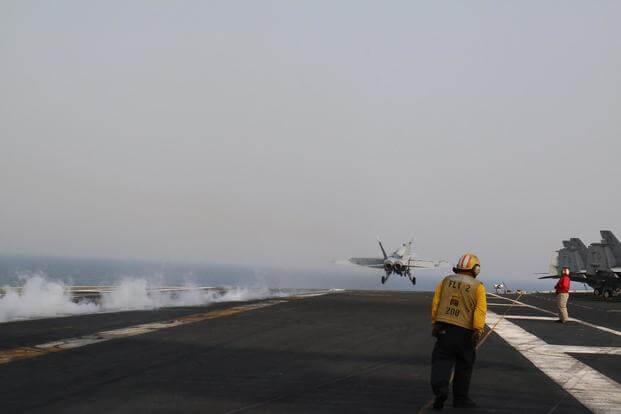For Navy aviation, a resurgence of hypoxia-like episodes in fighter aircraft has made for a difficult year -- a fact underscored in July when an F/A-18 Hornet squadron deployed aboard the carrier George H.W. Bush in support of the fight against ISIS paused operations for a full week after pilots experienced problems on back-to-back days.
But that step, a dramatic response to what the Navy has called its No. 1 aviation concern, may also be a sign of positive cultural change, said Capt. Dave "DW" Kindley, manager for the F/A-18 Hornet and EA-18G Growler program office.
During an interview at the Pentagon regarding the service's effort to solve what it calls "physiological episodes," Kindley praised the leadership aboard the carrier who grounded Strike Fighter Squadron 37 even in a busy operational environment.
"This is a CO who sees something he's uncomfortable with, and he stepped forward and said, 'We need to stop and look at our aircraft,' " Kindley said. "Wow, that's a good thing that that guy can jump forward and say that, and the naval aviation enterprise came and said, 'Right, we back you 100 percent.' "
Related content:
- Navy T-45 Squadron Pauses Operations After Crash Kills Two
- Cockpit Episodes Continue After Navy T-45s Resume Training Flights
- Cockpit Oxygen Episodes Sideline Navy Pilots Fighting ISIS
The head of the Navy's new Physiological Episode Action Team, Capt. Sara "Clutch" Joyner, emphasized that fighter pilots have been experiencing cockpit episodes for decades, but may have faced pressure in the past to say nothing and deal with them privately.
"[A] fighter pilot came up to me, from the '80s, and said, 'I had a physiological episode, and I wouldn't have told anybody that I had it,' " she said. "And he was disoriented, his whole crew helped him land the aircraft at the time, and they didn't tell anybody. That was just not something you did."
For the Navy, a more open cultural environment may help explain troubling increases in hypoxia-like incidents and other physiological episodes that affect its Hornets and Growlers, as well as its T-45C Goshawk trainers.
According to data published by the Navy in June, incidents involving Hornets and Growlers soared to a 25-year high in 2016, with 125 reported episodes. In 2015, there were 89 incidents, and just 56 in 2014.
As of June, there had already been 52 incidents this year, according to the data.
For T-45s, 2016 also represented an all-time high, with 38 cockpit incidents reported, compared to 27 in 2015 and just 12 in 2014.
As of June, there had been 21 incidents reported before the Goshawk fleet paused operations in April due to the surge in physiological episodes. There have been at least four since training flights resumed in August.
For the legacy Hornet, which entered service in the early 1980s and is rapidly approaching retirement, age is another key factor in play.
"The airframes are aging and changing in ways that maybe are not within the boundaries of what we originally designed," Joyner said. "And now we're beginning to understand that some of these excursions that we see are not helping the human in the loop, and they're causing them to be impacted."
Regarding the Hornet, officials are concentrating on more accurate oxygen flow and pressure change measurements in hopes of alerting pilots early when problems arise.
In addition, they are working to replace certain components before they break down to head off potential issues.
As Military.com first reported, the Navy in June began issuing each Hornet and Growler pilot a Garmin Fenix 3 watch to measure air pressure and altitude as an added tool to detect abnormalities in the atmosphere.
Pilots are also getting "slam sticks" -- matchbook-sized devices that fit in a uniform breast pocket and can take atmospheric readings. These can then be downloaded following a flight to assess any problems or unusual conditions.
Garmin has also designed an app the Navy can use with the watches, Kindley said.
Meanwhile, the service is performing a reset on Hornet environmental control systems, or ECS.
And VFA-37, the squadron that paused operations for a week on its deployment, has already completed the first phase after returning to homeport in Norfolk, Virginia, in August.
"Instead of flying components to failure, let's get a better understanding of where you think they'll fail and get to them before," Kindley said. "It wasn't that one part was going bad; it was that a number of them were interacting and causing surging or pressurization issues in the cockpit as a result."
Ultimately, the Navy has few conclusive answers so far regarding why physiological episodes happen or what can stop them in the future. But increased incident statistics, they suggest, may not be entirely bad news.
"I think there's been a change in culture that's probably really positive," Kindley said.
-- Hope Hodge Seck can be reached at hope.seck@military.com. Follow her on Twitter at @HopeSeck.































